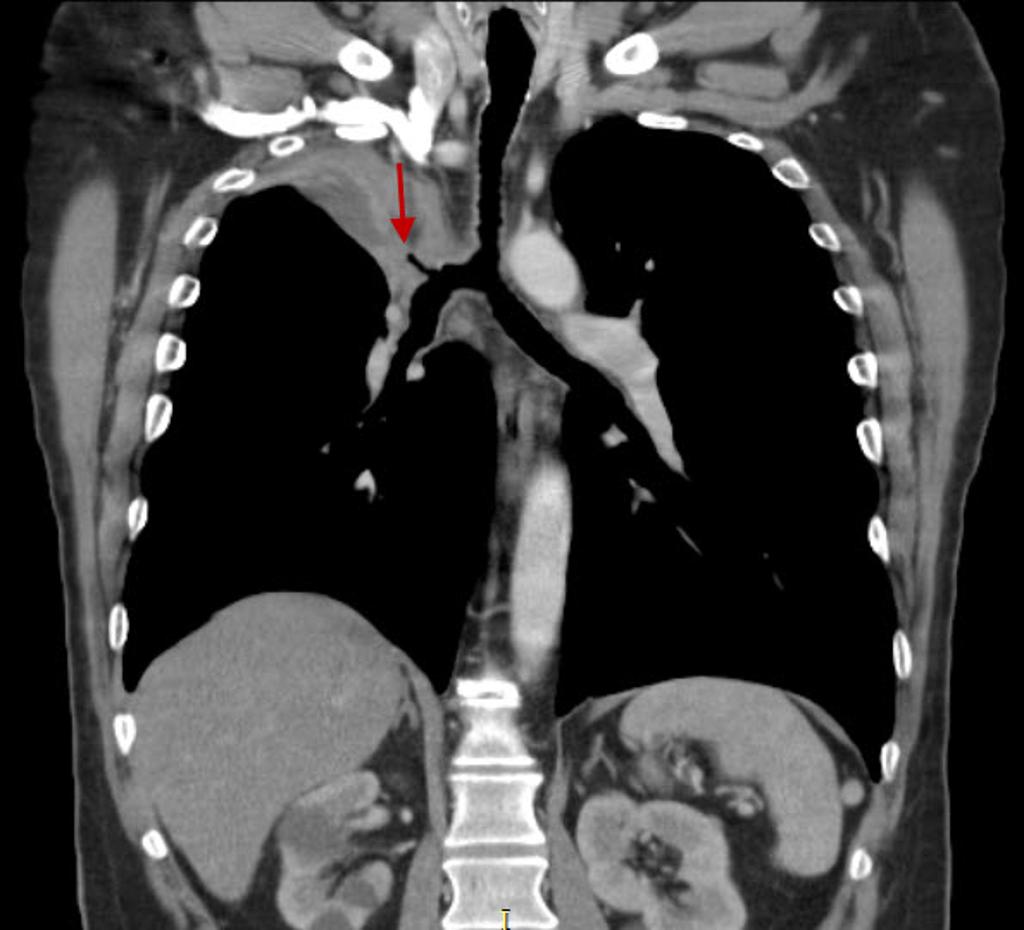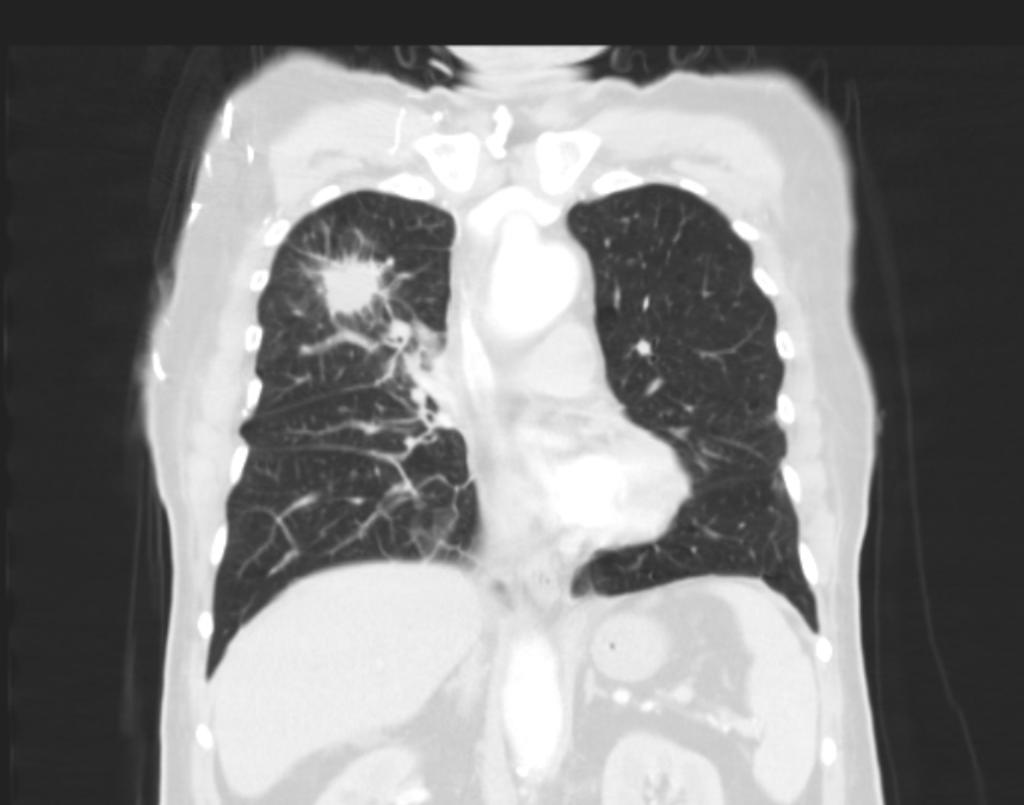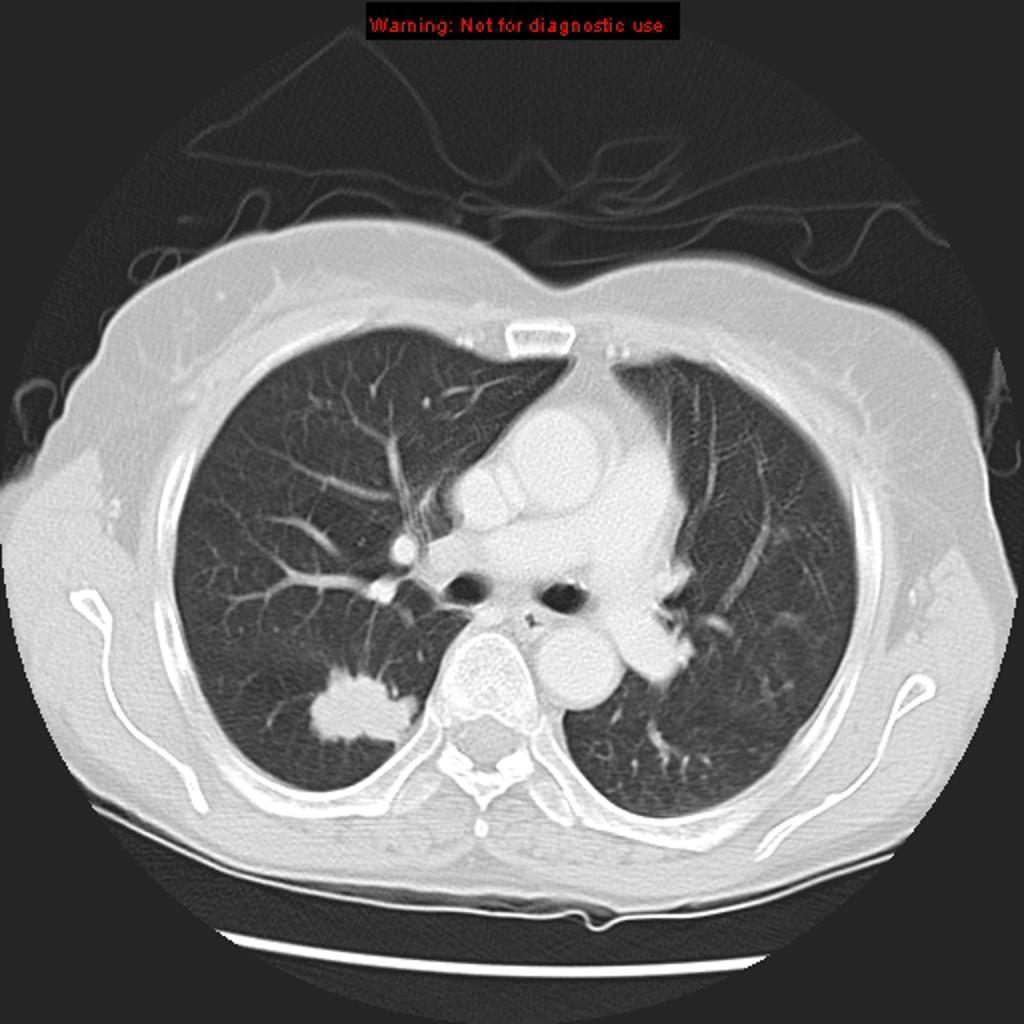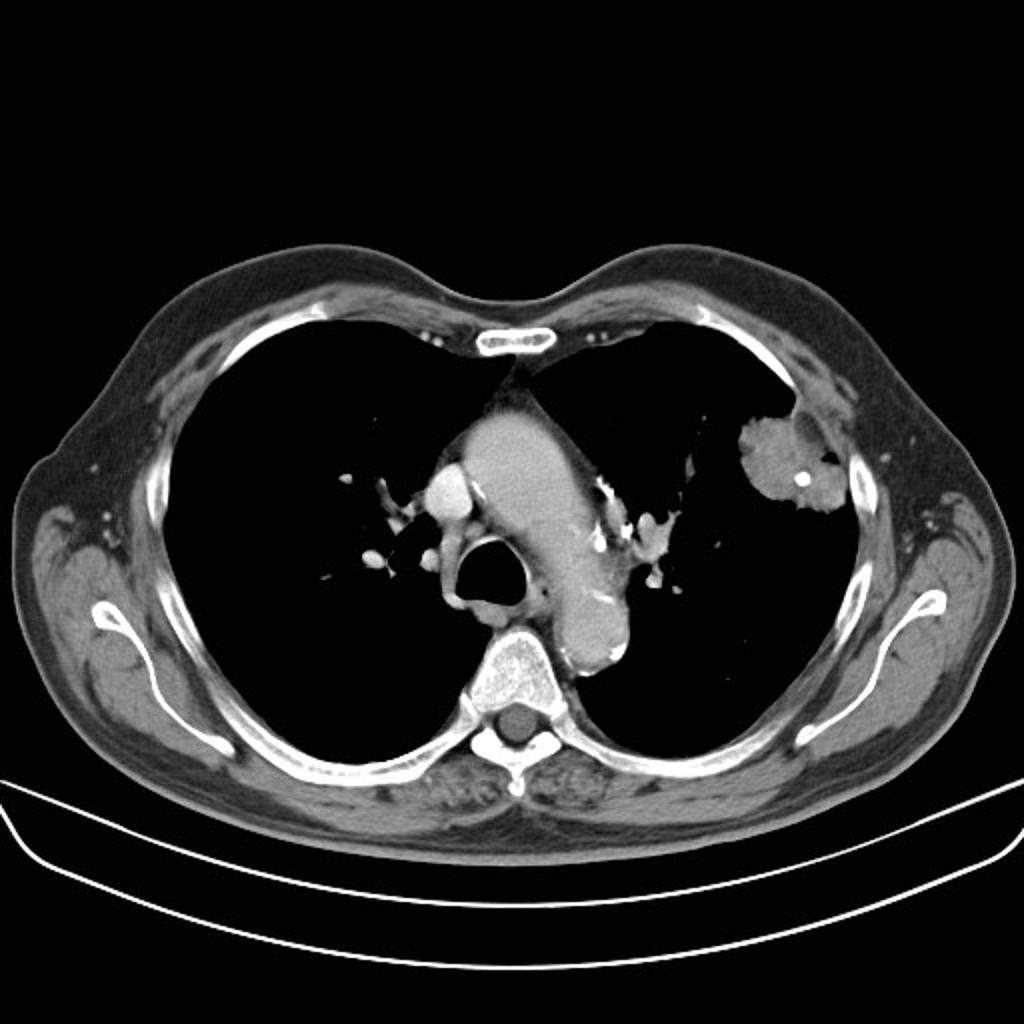Non small cell lung cancer CT: Difference between revisions
(→CT) |
|||
| Line 5: | Line 5: | ||
==Overview== | ==Overview== | ||
Computed tomography is the method of choice for the diagnosis of non-small cell lung cancer. On CT, characteristic findings of non-small cell lung cancer include ground-glass opacity, rounded or spiculated mass, local nodal involvement, intraluminar obstruction, and lobar collapse. | Computed tomography is the method of choice for the diagnosis of non-small cell lung cancer. On CT, characteristic findings of non-small cell lung cancer include [[Ground glass opacification on CT|ground-glass opacity]], rounded or spiculated mass, local nodal involvement, intraluminar obstruction, and lobar collapse. | ||
==CT== | ==CT== | ||
| Line 12: | Line 12: | ||
*In some cases, non-small cell lung cancers require further evaluation with [[MRI]] | *In some cases, non-small cell lung cancers require further evaluation with [[MRI]] | ||
*Common features of CT scan for the diagnosis of non-small cell lung cancer include: | *Common features of CT scan for the diagnosis of non-small cell lung cancer include: | ||
:*Assessment of the main bronchi | :*Assessment of the main [[bronchi]] | ||
:*Evaluation of the entire thorax | :*Evaluation of the entire thorax | ||
:*Detection of chest wall invasion | :*Detection of chest wall invasion | ||
:*Assessment of hilar and mediastinal invasion/adenopathy | :*Assessment of [[Hilar lymphadenopathy|hilar]] and mediastinal invasion/adenopathy | ||
:*Determination of non-small cell lung cancer staging | :*Determination of non-small cell lung cancer staging | ||
:*Precise determination of size and tumor dimensions | :*Precise determination of size and tumor dimensions | ||
| Line 24: | Line 24: | ||
*'''[[Adenocarcinoma of the lung|Lung adenocarcinoma]]''' | *'''[[Adenocarcinoma of the lung|Lung adenocarcinoma]]''' | ||
:*Lung adenocarcinomas are typically peripherally located | :*Lung adenocarcinomas are typically peripherally located | ||
:*Usually measure <4 cm in diameter, very few show cavitation | :*Usually measure <4 cm in diameter, very few show [[cavitation]] | ||
:*Perihilar and mediastinal involvement | :*[[Hilar lymphadenopathy|Perihilar]] and [[Mediastinal mass|mediastinal]] involvement | ||
:*Ground glass opacity (slow growth), usually lesions double the size within a year | :*[[Ground glass opacification on CT|Ground glass opacity]] (slow growth), usually lesions double the size within a year | ||
*'''[[Bronchoalveolar carcinoma]]''' | *'''[[Bronchoalveolar carcinoma]]''' | ||
:*Subtype of adenocarcinoma | :*Subtype of adenocarcinoma | ||
:*Single pulmonary nodule or mass | :*Single [[pulmonary nodule]] or mass | ||
:*Multicentric or diffuse disease | :*Multicentric or diffuse disease | ||
:*Localized area of parenchymal consolidation | :*Localized area of parenchymal consolidation | ||
:*Bubble-like areas of low attenuation within the mass are a characteristic finding | :*Bubble-like areas of low attenuation within the mass are a characteristic finding | ||
:*Hilar and mediastinal lymphadenopathy is uncommon | :*[[Hilar lymphadenopathy|Hilar]] and [[mediastinal lymphadenopathy]] is uncommon | ||
:*Persistent peripheral consolidation with associated nodules | :*Persistent peripheral consolidation with associated [[Pulmonary nodule|nodules]] | ||
*'''[[Squamous cell carcinoma of the lung|Squamous cell lung carcinoma]]''' | *'''[[Squamous cell carcinoma of the lung|Squamous cell lung carcinoma]]''' | ||
:*Centrally located within the lung | :*Centrally located within the lung | ||
:*Usually measure larger than 4 cm in diameter | :*Usually measure larger than 4 cm in diameter | ||
:*Frequent cavitation | :*Frequent [[cavitation]] | ||
:*Commonly cause segmental or lobar lung collapse due to central location | :*Commonly cause segmental or lobar lung collapse due to central location | ||
*'''[[Large cell carcinoma of the lung|Large cell lung carcinoma]]''' | *'''[[Large cell carcinoma of the lung|Large cell lung carcinoma]]''' | ||
:*Rapid growth | :*Rapid growth | ||
:*Early metastasizes to the mediastinum and brain | :*Early metastasizes to the [[mediastinum]] and brain | ||
:*Large mediastinal nodules/masses | :*Large mediastinal nodules/[[Mediastinal mass|masses]] | ||
:*Lymph node involvement (frequently subcarinal) | :*Lymph node involvement (frequently subcarinal) | ||
:*Nodular pleural thickening | :*Nodular [[pleural]] thickening | ||
:*Pleural effusion | :*[[Pleural effusion]] | ||
*On CT, signs of non-small cell lung cancer may include:<ref name="pmid7208937">{{cite journal |vauthors=Kundel HL |title=Predictive value and threshold detectability of lung tumors |journal=Radiology |volume=139 |issue=1 |pages=25–9 |year=1981 |pmid=7208937 |doi=10.1148/radiology.139.1.7208937 |url=}}</ref><ref name="pmid19234288">{{cite journal |vauthors=Parker MS, Chasen MH, Paul N |title=Radiologic signs in thoracic imaging: case-based review and self-assessment module |journal=AJR Am J Roentgenol |volume=192 |issue=3 Suppl |pages=S34–48 |year=2009 |pmid=19234288 |doi=10.2214/AJR.07.7081 |url=}}</ref> | *On CT, signs of non-small cell lung cancer may include:<ref name="pmid7208937">{{cite journal |vauthors=Kundel HL |title=Predictive value and threshold detectability of lung tumors |journal=Radiology |volume=139 |issue=1 |pages=25–9 |year=1981 |pmid=7208937 |doi=10.1148/radiology.139.1.7208937 |url=}}</ref><ref name="pmid19234288">{{cite journal |vauthors=Parker MS, Chasen MH, Paul N |title=Radiologic signs in thoracic imaging: case-based review and self-assessment module |journal=AJR Am J Roentgenol |volume=192 |issue=3 Suppl |pages=S34–48 |year=2009 |pmid=19234288 |doi=10.2214/AJR.07.7081 |url=}}</ref> | ||
:* '''Finger in glove sign''': | :* '''Finger in glove sign''': The bronchus distal to the obstruction is dilated. | ||
:* '''Crazy-paving sign''': | :* '''Crazy-paving sign''': Appearance of [[Ground glass opacification on CT|ground-glass opacity]] with superimposed interlobular septal thickening and intralobular reticular thickening. | ||
==Gallery== | ==Gallery== | ||
Revision as of 23:07, 23 February 2018
|
Non Small Cell Lung Cancer Microchapters |
|
Differentiating Non Small Cell Lung Cancer from other Diseases |
|---|
|
Diagnosis |
|
Treatment |
|
Case Studies |
|
Non small cell lung cancer CT On the Web |
|
American Roentgen Ray Society Images of Non small cell lung cancer CT |
|
Directions to Hospitals Treating Non small cell carcinoma of the lung |
|
Risk calculators and risk factors for Non small cell lung cancer CT |
Editor-In-Chief: C. Michael Gibson, M.S., M.D. [1]Associate Editor(s)-in-Chief: Maria Fernanda Villarreal, M.D. [2]
Overview
Computed tomography is the method of choice for the diagnosis of non-small cell lung cancer. On CT, characteristic findings of non-small cell lung cancer include ground-glass opacity, rounded or spiculated mass, local nodal involvement, intraluminar obstruction, and lobar collapse.
CT
Computed tomography is the method of choice for the diagnosis of non-small cell lung cancer.[1][2][3]
- In some cases, non-small cell lung cancers require further evaluation with MRI
- Common features of CT scan for the diagnosis of non-small cell lung cancer include:
- Assessment of the main bronchi
- Evaluation of the entire thorax
- Detection of chest wall invasion
- Assessment of hilar and mediastinal invasion/adenopathy
- Determination of non-small cell lung cancer staging
- Precise determination of size and tumor dimensions
- Detection of liver, bone, adrenal , and brain metastasis
On CT, characteristic findings of non-small cell lung cancer include:[3]
- Lung adenocarcinomas are typically peripherally located
- Usually measure <4 cm in diameter, very few show cavitation
- Perihilar and mediastinal involvement
- Ground glass opacity (slow growth), usually lesions double the size within a year
- Subtype of adenocarcinoma
- Single pulmonary nodule or mass
- Multicentric or diffuse disease
- Localized area of parenchymal consolidation
- Bubble-like areas of low attenuation within the mass are a characteristic finding
- Hilar and mediastinal lymphadenopathy is uncommon
- Persistent peripheral consolidation with associated nodules
- Centrally located within the lung
- Usually measure larger than 4 cm in diameter
- Frequent cavitation
- Commonly cause segmental or lobar lung collapse due to central location
- Rapid growth
- Early metastasizes to the mediastinum and brain
- Large mediastinal nodules/masses
- Lymph node involvement (frequently subcarinal)
- Nodular pleural thickening
- Pleural effusion
- Finger in glove sign: The bronchus distal to the obstruction is dilated.
- Crazy-paving sign: Appearance of ground-glass opacity with superimposed interlobular septal thickening and intralobular reticular thickening.
Gallery
-
Bronchogenic lung carcincoma: upper lobe collapse
-
Bronchogenic lung carcincoma: upper lobe with lymphangitic spread
-
Adenocarcinoma of the lung: ground-glass attenuation corresponds to a lepidic growth pattern and the solid component correspond to invasive patterns.
-
Squamous cell lung carcinoma: Peripheral squamous cell lung carcinoma may be seen as a solid nodule/mass with or without an irregular border. The irregular margin can be attributed to a desmoplastic reaction or infiltrative growth
References
- ↑ Rosado-de-Christenson ML, Templeton PA, Moran CA (1994). "Bronchogenic carcinoma: radiologic-pathologic correlation". Radiographics. 14 (2): 429–46, quiz 447–8. doi:10.1148/radiographics.14.2.8190965. PMID 8190965.
- ↑ 2.0 2.1 Parker MS, Chasen MH, Paul N (2009). "Radiologic signs in thoracic imaging: case-based review and self-assessment module". AJR Am J Roentgenol. 192 (3 Suppl): S34–48. doi:10.2214/AJR.07.7081. PMID 19234288.
- ↑ 3.0 3.1 3.2 Kundel HL (1981). "Predictive value and threshold detectability of lung tumors". Radiology. 139 (1): 25–9. doi:10.1148/radiology.139.1.7208937. PMID 7208937.



